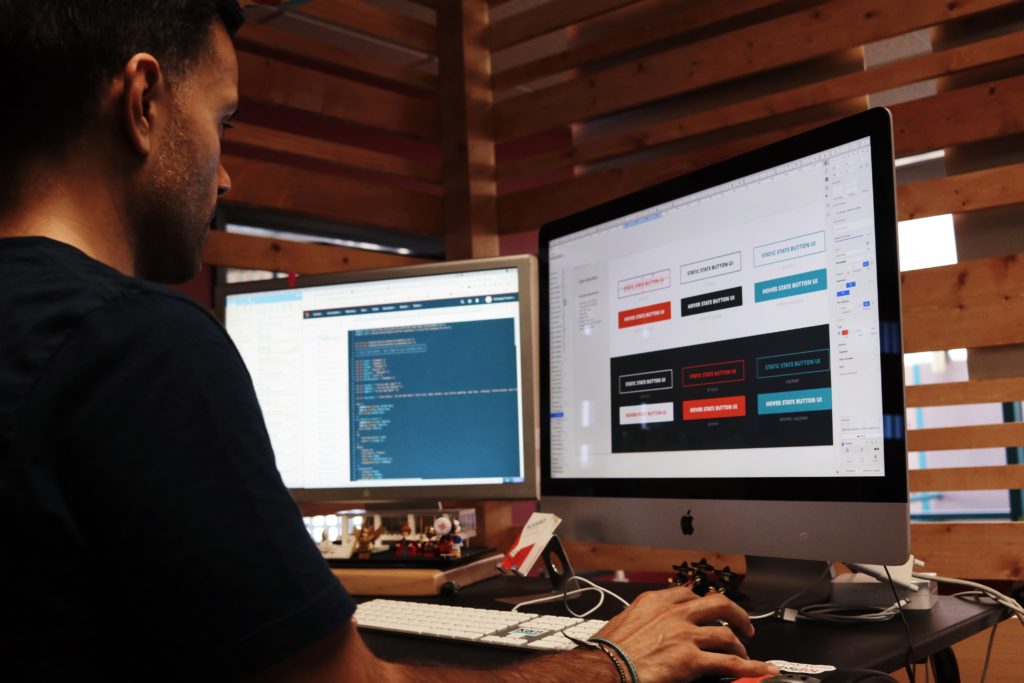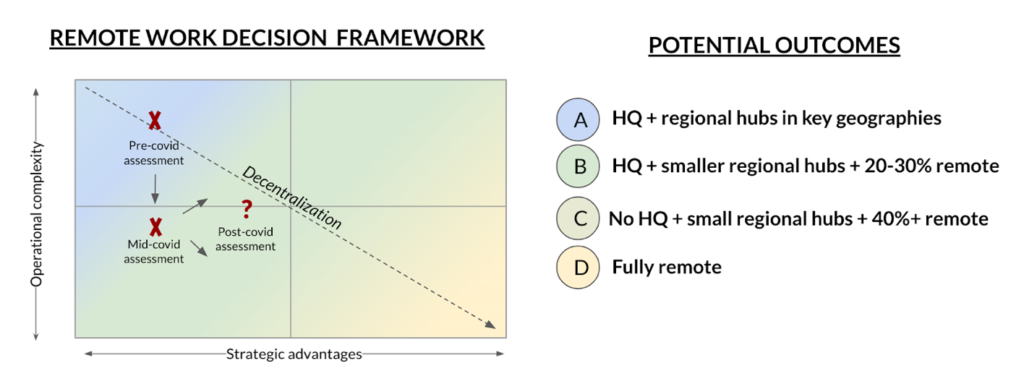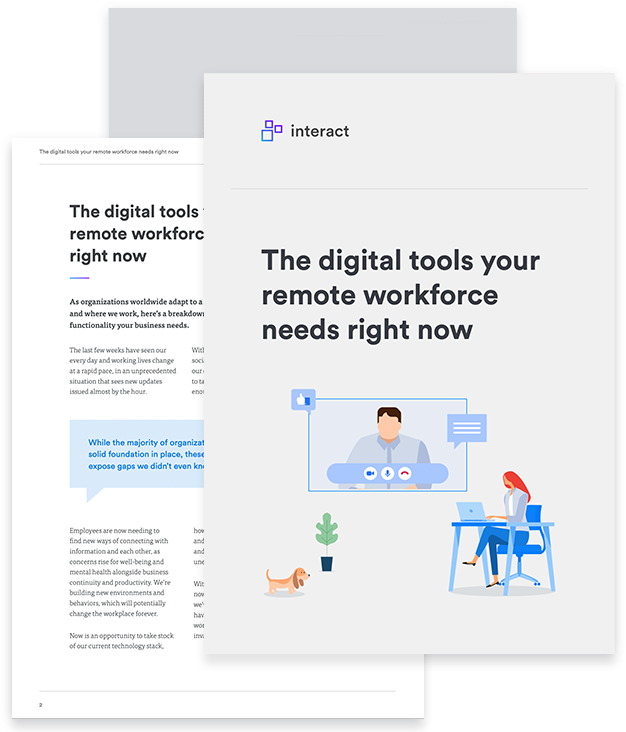COVID-19 forced an acceleration of digital transformation for organizations worldwide, with new tools and processes rapidly deployed to meet an immediate need. As we move forward, what’s next for our digital workplaces?
There’s no denying that the COVID-19 pandemic has forced a shift in how organizations run their operations and manage their people.
Business continuity has only been made possible thanks to technology: those leveraging existing and new tools to meet new needs, adapt to unique and ever-changing circumstances, and connect employees during the outbreak.
With talk of the ‘new normal’ circulating and lockdown measures easing, it’s time to think seriously about what comes next.
No matter what stage your digital workplace was before the pandemic, it’s likely your organization needed to push through new tools, platforms, or processes at pace. Even those who were better prepared needed to adjust; and despite 70% of organizations either having a digital transformation strategy in place or actively working on one, it’s safe to assume the rapid turn of events probably sped up or changed those transformation initiatives from the original plan.
When we’re forced to move fast, compromises are needed. We may waiver normal governance, due diligence, or strategy, place a lower emphasis on the user experience, or need to leave gaps that can be filled when pressures lift. Many large organizations also struggled with increased network loads, security concerns, and more.
We’re also facing the reality that our ‘new normal’ may not match the environment or needs we identified before the pandemic. Workforces may continue working remotely, either full-time or in a hybrid format, for the foreseeable future. We’ll need to adapt our customer or client operations to meet new standards for service provision safely.
We’re not saying throw out the original roadmap entirely. However, it’s time to re-evaluate our priorities for the digital workplace going forward.
So, what do we need to consider?
The digital tools your remote workforce needs
#1. New customer, client, and service user processes
Stark warnings from scientists over the threat of a ‘second wave’ and a lack of vaccine mean every organization has a social responsibility to minimize the risk of infection. We have to consider how to adapt operations and reduce close interactions or contaminated surfaces spreading the virus further.

Some industry sectors will have undeniable challenges even technology can’t overcome. Kurt Geiger has already stated it will quarantine its shoes for 24 hours after customers try them on, while Waterstones will put books under a 72-hour isolation period after being handled, in a bid to ‘allow the virus to die’. Some creative workarounds are going to personify the next phase.
However, technology can – and has – stepped up in areas including online shopping or service provision, virtual events, classes, or service sessions, technology-enabled self-service, and delivery or click-and-collect services as an alternative to in-store purchasing. Management of customer flow in physical spaces through pre-booking or slot allocation has also seen a sharp increase.
We’re also seeing a surge in the adoption of tools that will create socially-distanced experiences using technology; for example, the release of a new app, ‘Glug’, will support the hospitality industry by removing queues and reducing contact through cash or card exchange. More widespread use of existing technologies for takeout orders and delivery will be brought in-store; not new, but thanks to the pandemic, applied in a different context with wider adoption.

Many leaders have already broken down their customer touchpoints and crafted workaround solutions as part of business continuity planning.
Now is the time to ensure temporary solutions are made more stable for long-term provision, to identify gaps as social distancing restrictions lift, and to use technology to both inform staff of new processes or protocols and continually monitor solutions.
#2. ‘Contactless’ employee journeys
Of course, our responsibilities don’t stop with our customers. The focus on the provision of protective measures for employees has dominated headlines for some industries more than others – healthcare, care homes, and supermarkets in particular – but as more restrictions lift, there are further risks facing staff.
In particular, non-standard workers in tourism, travel, retail, and face-to-face service provision (such as hairdressing or physical therapy) face higher levels of risk due to exposure, but consistently see gaps in social protections that will be even more acute in the return to work. An inclusive, end-to-end assessment of needs to minimize risk is critical.

“In these tragic circumstances, there is a lesson for the future: the experience of [these] workers shows going digital means more than just shifting channels. It is about refitting our labour markets, social protection, and welfare systems and making sure everyone has the ability to realise the human right to social security in the post-Covid-19 digital era.”
– Dr Maria Mexi, International Labour Organization
Alongside minimizing contact points between customers and employees, we’ll need to focus on employee interactions and overhauling the traditional employee lifecycle to craft contactless employee journeys. This spans from recruitment and onboarding through to training, and from unlocking storefronts to managing break rooms or in-store cleaning and stock management.
Technology may not be the answer to all challenges, but can certainly be a supporting agent; whether that’s through effective spacing of bookings or internal rotas, ordering of protective equipment, virtual or distanced onboarding and training programs, or digital processes and workflows for day-to-day operations, such as access to premises, ordering or signing for supplies, or fulfilling HR protocols.
The digital tools your remote workforce needs
#3. Make rapid COVID-19 digital deployments more robust and sustainable
This is the big one, particularly for those organizations that brought forward deployments or made rapid decisions off-roadmap to meet an immediate, time-pressured need.
Making those new digital solutions fit for the long-term digital workplace requires some work, which is now possible as we have time to take stock.
Areas to address will include:
- Governance: solutions assembled in haste are unlikely to have defined governance, which can present challenges further down the line when content or information becomes buried. A retrospective job can still do the trick at this stage; assigning important elements including ownership, a defined information architecture, and guidelines around naming, tagging, review dates, and more.
- Security and compliance: without time for due diligence or risk assessment, there are potential risk points in newly overhauled systems and processes.
If corners have been cut from necessity, or best practice ignored in the push to get new systems operational, it’s time to plug the gaps and ensure compliance.
For those organizations that have shifted to device-led models to enable remote working, it’s time to establish cloud server-based solutions and roll out necessary compliance governance to get ownership of data back in the hands of organizations.

- Evaluate and streamline solutions: forced to adapt to new circumstances, many employees have experimented with new ways of connecting and collaborating, seeing a surge in the Bring Your Own App economy.
Mastering this growth in shadow IT will call for an evaluation of what has worked successfully and identifying where duplicated platforms now need streamlining. There may be tools that were considered previously but not adopted large scale; one of the side benefits of the pandemic has been enforced agility which means many barriers have been overcome.
If your remote teams are now using Teams, Zoom, and Slack for virtual meetings, what is the right solution for your organization going forward? What are the security concerns of shadow-IT solutions that have been rolled out?
Keeping things simple works short-term, but is there untapped potential residing in your new (or existing) digital workplace tools?
- Refine UX: making user journeys seamless, enjoyable, visually appealing, and simple to use probably didn’t rank top of the priority list when facing rapid change and resource pressures.
Governance may address some shortcomings; but now is the time to look at elements that can transform the user experience such as design, accessibility, functionality, and more. If there are multiple solutions on the table for potential eviction, this needs to be one of the priorities.

- Build out features: with speed to launch the top priority for many organizations looking to kit out newly remote workforces, skeletal or basic renditions are often the default option for digital tools.
Keeping things simple works short-term, but is there untapped potential residing in your new (or existing) digital workplace tools? We’ve seen many intranet projects, for example, launching with business-critical functionality in the first phase. Additional features can now be considered for the second phase of development. - Upskill and train employees: while many employees have learned during the rollout of tools essential for business continuity, few organizations have had the time or means to deliver comprehensive training on new tools or processes.
By upskilling staff, you’ll ensure greater adoption and engagement of tools, adherence to governance and best practices, and address skill gaps that can trigger high volumes of tickets or potential security and compliance errors. Ensure you’re also identifying additional administrators, content authors, or support staff for effective management long-term.
While a sense of ‘making do’ is acceptable in the short-term, bringing solutions up to enterprise-grade level is paramount for long-term performance and stability.
The digital tools your remote workforce needs
#4. Evolve digital workplaces for long-term hybrid working models
Initial lockdown proceedings saw many organizations roll out large-scale remote working with little understanding of how long it might last. Now we’re months into the process, research and anecdotal evidence suggest it’s here to stay: even beyond the pandemic.

It’s time to make those digital workplace models more robust.
Naturally, organizations will differ in terms of their long-term objectives for working models; some will never be the same as before.
Regardless of where on the decentralization decision framework an organization falls or will strive to return to – fully or partially remote, or a hybrid approach – the tools and platforms that support staff working from home need to work in harmony with in-house solutions, supporting both ways of working intuitively and simply.

Staff must be able to move from one state to another without jarring their overall digital employee experience: calling for considerations around accessibility, access, integrations, and authentication.
Working remotely should be as simple as working within the office, and vice-versa; centralized and cloud-based document management, easy access to information, and the ability to log into all applications regardless of location are vital.
In the same vein, creating the same spaces and ways of working that we see in the office is essential in the digital realm. Many have mastered variations of this, creating digital spaces for a variety of collaboration models or ways of working, as Sam Marshall explores in his article here.
The question is whether our organizations can progress to a hybrid variation, with in-office and virtual meetings taking place without any hindrance to productivity, engagement, or experience. Evaluating existing digital workplace tools for their effectiveness in both scenarios and addressing gaps must inform the “new normal” digital workplace strategy.
#5. Resilience and agility to futureproof against potential incidents
Even those best-prepared for crisis response couldn’t have anticipated the scale and impact of the pandemic. Some may have found themselves completely under-prepared.

The ability to respond rapidly, deploy new models, tools, or processes quickly, and empower wide-scale remote working to ensure business continuity is what will set successful organizations apart long-term.
Although projections for the pandemic recovery vary, the possibility of future spikes or further periods of lockdown is probable. Instilling effective response models and agile digital workplace solutions with make for smoother, stable transitions between different states.
In practical terms, this means ensuring sufficient access and permissions for staff who may need to work from home, tools for rapid response communications, and digital feedback loops for employees to connect with managers, teams, and the organization as a whole.
Accessibility, for example, through the use of a communications app for frontline staff, needs to be on the radar.

Internally, digital processes and workflows for reporting, tracking, and isolating cases of COVID-19 should also be a part of your next-stage digital workplace planning.
If a staff member needs to self-isolate, can you identify potential contacts, those staff members who are considered ‘high risk,’ and ensure the necessary tasks, information, and projects can be seamlessly handed over to another member of staff?
The digital tools your remote workforce needs
#6. Developing our virtual cultures
The pandemic has shown that one of the greatest gaps in our existing digital workplaces is the social, interpersonal element that connects staff both to the organization, and one another.
Although cited as one of the greatest challenges for remote workers long before the pandemic, few organizations showed the ability to translate the often intangible aspect of “culture” into a virtual space.

With lockdown measures in place across the globe, we had no choice but to get creative. Organizations and staff alike sought to build meaningful connections, re-create company spirit or team camaraderie, and find ways of bringing the social into digital workspaces.
The corresponding positive impact on productivity, morale, engagement, and more, makes the case for investing in communicating our cultures clear.
As we embrace remote working for the long term, it’s time to think about how digital workplaces can support through embedding social tools, rich content, the means to share your mission, values, and success, to recognize employees, and give greater visibility of leadership.
A centralized intranet that embodies features to connect staff to their organization will prove a crucial tool in facilitating, nurturing, and communicating those virtual cultures going forward. Further still, they can create cohesion between physical and remote cultures: breaking down the siloes that have historically characterized the centralized vs. remote workforce.
We can never go back to exactly how we were before.

It’s not intended as a message of foreboding: in fact, it presents an opportunity for many.
We’re in an enforced process of rapid digital transformation, where many of the traditional ‘blockers’ to change have been removed for us. We’ve had to change, move forward, and apply innovative workarounds in order to drive business continuity in extraordinary circumstances.
For some, the pandemic exposed some potential ‘areas for improvement’ or gaps in their digital workplaces. For others, it was a serious wake-up call.
We started with a necessity to respond to the outbreak crisis. Now, we’re applying a long-term mindset, with staff and organizations alike questioning the necessity for office work and the threat of further outbreaks on the horizon to boot. It’s clear investment in our digital roadmaps will more than deliver a return.
Simply put, the next phase for our digital workplaces is the most important yet: and we must invest.



